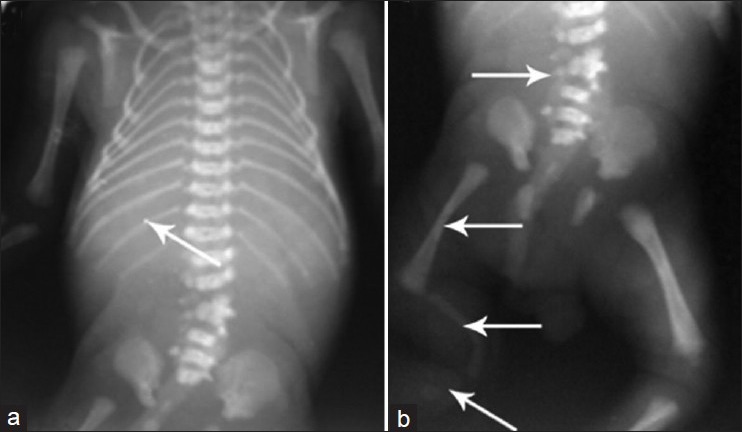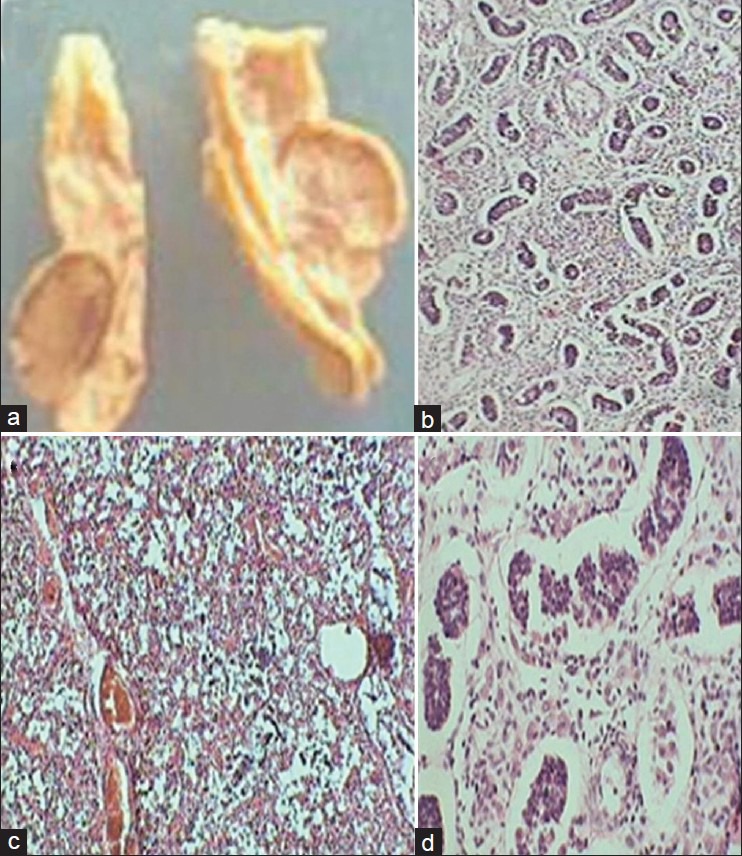Abstract
Potter's sequence is a rare fatal disorder that occurs in sporadic and autosomal recessive forms with an incidence of 1 in 4000 births. Babies born with this condition are either still born or die very early within the neonatal period. We report a case of Potter's sequence with the typical physical findings and histological findings.
Keywords: Potter facies, pulmonary hypoplasia, renal agenesis
INTRODUCTION
Potter's sequence was first described by Edith Potter in 1946.[1] It affects predominantly male babies and is accompanied by severe oligohydramnios, polycystic kidney, bilateral renal agenesis, and obstructive uropathy during middle gestational weeks. Renal failure is the main defect in Potter's sequence. Other characteristic features include premature birth, breech presentation, atypical facial appearance, and limb malformations. Severe respiratory insufficiency leads to a fatal outcome in most infants.[1] Here, we are presenting a case of Potter's sequence in a stillborn male baby. The sequence, as described by Potter in association with renal agenesis in stillbirths and neonatal deaths, is due to oligohydramnios and found bilateral pulmonary hypoplasia and immature lungs microscopically.[2,3] Amniotic fluid decreases as a result of leakage or inadequate production due to poor fetal urine output.
CASE REPORT
A 23-year-old woman, second gravida, of 35 weeks gestational age, delivered a stillborn male baby with spontaneous breech presentation. The baby weighed 1.5 kg. Placenta and membranes expelled with no liquor. Placenta was having marginal presentation, with normal fetal and maternal surfaces with complete cotyledons. Radiological examination of the baby revealed that there was absence of sacrum except first sacral vertebra, opaque lung fields, hypoplasia of right femur, absence of right fibula, and hypoplasia of right tibia with bowing [Figure 1]. Ultrasound examination showed non-visible kidneys, bladder, and severe oligohydramnios. Fetal autopsy was performed.
Figure 1.

Radiological findings showing opaque lung fields (hypoplastic), absence of sacrum except first sacral vertebra, hypoplasia of right femur, absence of right fibula, hypoplasia of right tibia with bowing
On autopsy, the following findings were noted. Typical Potter facies was noted which included flattened nose, recessed chin [Figure 2a], prominent bilateral epicanthal folds [Figure 2b], and low-set ears with wide pinna [Figure 2c]. Umbilical cord showed only two vessels composed of single umbilical artery [Figure 3a].
Figure 2.

Potter facies with flattened nose (a), prominent bilateral epicanthal folds (b, arrow) and low set ears with wide pinna (c, arrow)
Figure 3.

Single umbilical artery (a, arrow), absent anal opening (b), undeveloped genitalia, short right lower limb, right great toe displacement with CTEV (c)
Further examination revealed absence of anal opening and undeveloped genitalia [Figure 3b]. There was also presence of short right lower limb, displacement of great toe, and congenital talipes equino varus (CTEV) [Figure 3c]. Histopathologic examination of gonads showed hypoplastic gonads [Figure 4a and b]. Lungs were hypoplastic and non-breathed [Figure 4c and d]; heart, liver, and spleen were normal. Kidneys, urinary bladder, and rectum were not visualized.
Figure 4.

Hypoplastic gonads gross (a) undeveloped seminiferous tubules (b) H & E ×10, hypoplastic lungs (c) H & E ×10 and (d) H & E ×40
DISCUSSION
Potter's sequence describes the typical physical appearance caused by pressure in utero due to oligohydramnios. It can occur in conditions such as infantile polycystic kidney disease, renal hypoplasia, and obstructive uropathy. Some authors feel that Potter's sequence rather than Potter's syndrome is more appropriate terminology as all cases of this syndrome do not have exactly the same set of signs, but they share a common chain of events leading to the same endpoint of reduced or absent amniotic fluid. Decrease in the volume of amniotic fluid may be due to decreased urine production secondary to bilateral renal agenesis, obstruction to the urinary tract, or occasionally prolonged rupture of membranes. The resulting oligohydramnios is the cause of the deformities in Potter's sequence. During nephrogenesis, genes, transcription factors, and growth factors control the essential interaction between the ureteric bud and the metanephric mesenchyme. Various abnormalities are associated with renal agenesis or dysplastic kidney abnormalities, such as renal coloboma syndrome, Kallmann syndrome, and branchiootorenal syndrome. Newborn male babies have an increased incidence of the Potter's sequence because they have a higher rate of Eagle–Barrett (Prune belly) syndrome and obstructive uropathy secondary to posterior urethral valves.
The ultimate result is decreased amniotic fluid which results in typical features that we have noticed in our case.
Potter facies is described as having a flattened nose, recessed chin, prominent epicanthial folds, and low set of abnormal ears. The degree of pulmonary hypoplasia depends on the degree and duration of oligohydramnios, as well as the stage of lung development at which oligohydramnios occurs. In our case, all these findings were seen. Skeletal malformations may include hemivertebrae, sacral agenesis, and limb anomalies.[4]
The evaluation of patients with the Potter's sequence should include an examination for nonrenal defects, autopsy, chromosome analysis, and renal ultrasound or urologic evaluation of parents. Ultrasonographic prenatal monitoring of subsequent pregnancies in such families is strongly warranted because of a definite but unknown degree of recurrence risk.[5]
The term Potter's sequence is most frequently associated with the condition of oligohydramnios sequence regardless of the root cause of the absence or reduced volume of amniotic fluid. We present this case to highlight the rarity of Potter's sequence. Regular follow-up and antenatal checkup should be done to diagnose oligohydramnios to prevent the complications resulting from it. Not all oligohydramnios cases will lead to Potter's sequence, but careful examination of the fetus and regular amniotic fluid index should be done to prevent the consequence.
Footnotes
Source of Support: Nil
Conflict of Interest: None declared.
REFERENCES
- 1.Khatami F. Potter's syndrome: A study of 15 patients. Arch Iranian Med. 2004;7:186–9. [Google Scholar]
- 2.Jain M, Agarwal S, Mandal S. Variation in clinical and genitourinary lesions associated with pulmonary hypoplasia in Potter's syndrome-two autopsy reports. Indian J Pathol Microbiol. 2006;49:416–8. [PubMed] [Google Scholar]
- 3.Nakamura Y, Funatsu Y, Yamamoto I, Yamana K, Nishimura T, Hosokawa Y, et al. Potter's syndrome associated with renal agenesis or dysplasia. Morphological and biochemical study of the lung. Arch Pathol Lab Med. 1985;109:441–4. [PubMed] [Google Scholar]
- 4.Dhundiraj KM, Madhukar DN, Ambadasrao PG, Wamanrao KS, Prem ZM. Potter's syndrome: A report of 5 cases. Indian J Pathol Microbiol. 2006;49:254–7. [PubMed] [Google Scholar]
- 5.Curry CJ, Jensen K, Holland J, Miller L, Hall BD. The Potter sequence: A clinical analysis of 80 cases. Am J Med Genet. 1984;19:679–702. doi: 10.1002/ajmg.1320190408. [DOI] [PubMed] [Google Scholar]


